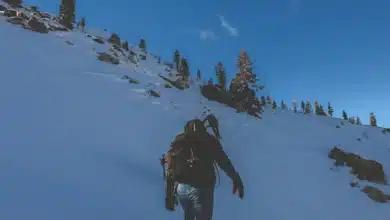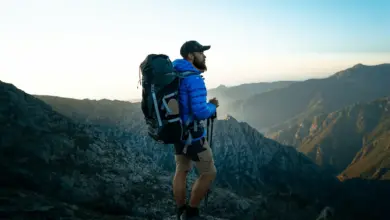On the Trail
On the Trail
Winter hiking takes some additional skill and navigation. You’ll have to carry more gear, regulate body temperature, and pay extra careful to the trail. There are also other dangers such as ice and hypothermia. This page will discuss winter hiking safety such as pacing, staying warm on the trail, and the best way to hike in groups.
Pacing
After the first half hour or so, you’ll start to find a good rhythm that works. If you are stopping frequently to catch your breath or to rest, then you are moving too quickly. When you rest, it should mostly be to drink some water, grab a snack, and look at the map. Keep in mind on multi-day trips, the first day or two, your body will still be getting adjusted to its new environment and to your equipment.
Thermo-Regulation
When hiking, the body will warm up quickly. One starting out, your body should be a little cold. After about 10 minutes, your body will start to warm up. And if you need to stop to take off or put on another layer, don’t be afraid to stop and do it. When winter hiking, it’s important to keep all your clothes dry. If you begin to sweat too much, try taking off or adjusting a layer. If it begins to snow, put on a shell. If you happen to stop by someplace warm or near a fire, take advantage to dry out any wet clothes. If you’re drying clothes by a fire, be careful of flying embers that may damage your clothing.
You may also like Easiest Tents to Set Up by Yourself
Staying Together
When hiking in a group, the group members will have different experiences, gear, and fitness levels. One way to make sure everyone is taken care of is if everyone takes responsibility for the person behind them. This way, nobody lags behind and gets separated. If someone needs to stop, then the whole group should stop. Nobody should ever get left behind. Sometimes members would like some extra distance from other members to experience the stillness and beauty of their environment. This is fine as long as nobody is out of eyesight.
The group should travel at the pace of the slowest member. If the group is too fast for the slowest person, the slower person will have to use more energy to catch up and will start to become demoralized. A good way to prevent this is to have the slower member lead the group for a little while. This will allow the member to go at their own pace and get a psychological boost.
There are other reasons to want to rotate leaders. If a leader is breaking the trail, they may tire quicker than the rest of the group. If the leader gets tired, a nice technique is for the leader to step aside to rest and join the group at the rear when it passes. If each member does this, the person who was at the rear should be rested enough to take the lead again, and the cycle continues. Another technique to help break the trail is to give the leader a lighter load. Food and equipment can be divided by the rest of the members. The lighter pack can be passed around to new leaders when needed.
You may also like Are Winter Boots Waterproof? It Depends
Awareness
Being aware of your surroundings, your group, and yourself is always important, but it is especially more important in winter when there are more dangers. Being aware is all about listening. Listening to your environment and noticing any danger. Keep an eye out for ice and any storms that may be coming in. Listen to your group members and pay attention to snow safety such as hypothermia and frostbite. A member of the group who complains they are cold may be in greater danger. Always be listening with your eyes and ears.



